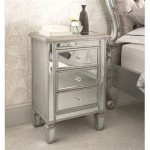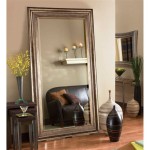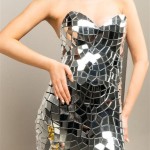Dressing Table Mirror Standard Size
Choosing the right dressing table mirror involves considering various factors, including size, shape, and style. Understanding standard sizes can significantly simplify this process, ensuring the mirror complements the dressing table and the overall bedroom aesthetic. While "standard" can be subjective and influenced by trends and manufacturer preferences, some common dimensions provide a useful starting point.
Key Considerations for Dressing Table Mirror Size
- Dressing Table Dimensions
- User Height
- Available Space
- Mirror Shape
- Desired Functionality (e.g., full-length view)
The size of the dressing table itself is the primary factor influencing the appropriate mirror size. A larger table can accommodate a larger mirror, while a smaller table requires a proportionally smaller one. Overly large mirrors on small tables can look disproportionate and overwhelm the space, whereas small mirrors on large tables can appear underwhelming and fail to serve their purpose effectively.
Common Dressing Table Mirror Sizes
- Small: Widths ranging from 30cm to 45cm are generally considered small and suitable for compact dressing tables or vanities. These are ideal for smaller bedrooms or where space is limited. They are typically used for close-up tasks like applying makeup.
- Medium: Medium-sized mirrors typically range from 45cm to 60cm in width. This size provides a good balance for most standard dressing tables, offering sufficient viewing area without dominating the space.
- Large: Mirrors wider than 60cm are considered large and are suitable for larger dressing tables or those designed for more elaborate grooming routines. These often provide a wider field of view, allowing users to see more of their outfit.
Beyond width, the height of the mirror is also a crucial dimension. The height should be sufficient to allow the user to comfortably view themselves while seated at the dressing table. This requires considering the individual's height and the height of the dressing table surface.
Mirror Height in Relation to User and Table
- User Height: Taller individuals generally require taller mirrors to achieve a comfortable view.
- Table Height: The height of the dressing table surface dictates the starting point for determining the appropriate mirror height. The mirror should be positioned to extend upwards from the table surface to accommodate the user's seated height.
- Sitting Position: Consider the typical sitting posture at the dressing table. The mirror should provide a clear view without requiring excessive leaning or straining.
Available space within the bedroom significantly impacts mirror size selection. A cramped room may not accommodate a large dressing table and mirror combination. Careful measurement of the available space is essential to ensure the chosen mirror fits comfortably without obstructing movement or creating a cluttered feel.
Space Considerations
- Room Dimensions: Measure the overall room dimensions to understand the available space.
- Placement: Consider where the dressing table and mirror will be placed within the room. Ensure sufficient clearance around the dressing table for comfortable movement.
- Wall Space: If the mirror is wall-mounted, accurately measure the available wall space to ensure a proper fit.
The shape of the mirror also plays a role in perceived size and overall aesthetics. Circular, oval, and rectangular mirrors are common choices. Circular and oval mirrors often appear smaller than rectangular mirrors of the same width due to their rounded edges. Rectangular mirrors are generally preferred for their practicality and ability to provide a larger viewing area.
Mirror Shape and Visual Impact
- Circular/Oval: Offer a softer, more decorative look but may provide a smaller viewing area.
- Rectangular: Offer a classic, practical design with a larger viewing area for a given width.
- Shape and Room Style: Consider the overall style of the bedroom when selecting a mirror shape. A more ornate or vintage-style room may benefit from a more decorative mirror shape, while a modern or minimalist room might suit a simple rectangular design.
Finally, the desired functionality of the mirror should inform the size selection. If the primary purpose is to apply makeup, a smaller mirror may suffice. However, if the user wants to see their entire outfit, a larger mirror or a full-length mirror may be necessary. Some dressing tables incorporate multiple mirrors or adjustable mirrors to offer greater flexibility.
Mirror Functionality and Size
- Makeup Application: Smaller mirrors are often sufficient for close-up tasks.
- Full-Length View: Larger mirrors or dedicated full-length mirrors are necessary for viewing the entire outfit.
- Multiple Mirrors: Some dressing tables offer multiple mirrors for different perspectives.

Standard Sizes And Dimensions Of Home Furniture Dressing Table Design Sketches

Standard Sizes And Dimensions Of Home Furniture Engineering Discoveries Dressing Table Mirror Design Small Washroom

Adaly Dressing Table Bluewud

Dressing Mirror Size Dimension Width 23 Inches Depth 14 Height 78 At Rs 13824 In Ratangarh

Standard Sizes And Dimensions Of Home Furniture Dressing Table Simple Design

Artiss Dressing Table Mirror Stool Jewellery Cabinet Makeup Organizer Drawer Myer

35 Standard Sizes For Diffe Types Of Furniture Engineering Discoveries Dressing Table Design Mirror Cupboard

Makeup Vanity Dimensions With Drawings Upgradedhome Com

Lanna Mirror Dressing Table With Stool White Furnituredirect Com My

Geneva Dressing Table With Mirror Stool Rawat Furniture








